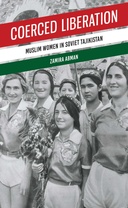Explore

In 1924, the Bolshevik regime began an unprecedented campaign to forcibly emancipate the Muslim women of Tajikistan. The emancipatory reforms included unveiling women, passing progressive family code laws, and educating women. By the 1950s, the Soviet regime largely succeeded in putting an end to veiling, child marriage, polygamy, and bride payments. Yet today there is a resurgence in these practices the Bolsheviks claimed to have eliminated. Coerced Liberation reveals that the Soviet regime transformed the lives of urban women within a single generation but without lasting effect. Drawing on unique primary sources, the book examines why this occurred. It addresses questions that are pertinent to ongoing debates in the international arena: What happens when an outside force attempts to modernize a society deeply rooted in centuries of patriarchal norms and values? In what ways can a devout religious rural community respond to, survive, and adapt to such interventions? And how does a state-centred, top-down approach towards women’s emancipation work? Coerced Liberation presents critical insights for readers interested in gender dynamics within Muslim communities, the roles of women in Islam, the resurgence of Islam in former colonial territories, the effectiveness of a top-down approach towards women’s movements, and more.
This book is included in DOAB.
Why read this book? Have your say.
You must be logged in to comment.
Rights Information
Are you the author or publisher of this work? If so, you can claim it as yours by registering as an Unglue.it rights holder.Downloads
This work has been downloaded 16 times via unglue.it ebook links.
- 16 - pdf (CC BY-NC-ND) at Unglue.it.
Keywords
- History / Asia / Central Asia
- thema EDItEUR::N History and Archaeology::NH History::NHF Asian history
Editions

